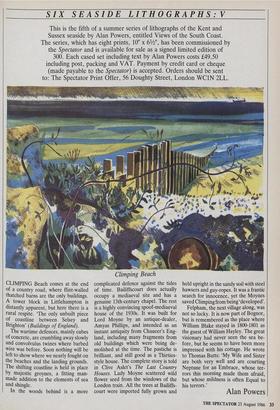SIX SEASIDE LITHOGRAPHS: V
This is the fifth of a summer series of lithographs of the Kent and Sussex seaside by Alan Powers, entitled Views of the South Coast. The series, which has eight prints, 10" x 61/2", has been commissioned by the Spectator and is available for sale as a signed limited edition of 300. Each cased set including text by Alan Powers costs £49.50 including post, packing and VAT. Payment by credit card or cheque (made payable to the Spectator) is accepted. Orders should be sent to: The Spectator Print Offer, 56 Doughty Street, London WC1N 2LL.
CLIMPING Beach comes at the end of a country road, where flint-walled thatched barns are the only buildings. A tower block in Littlehampton is distantly apparent, but here there is a rural respite. 'The only unbuilt piece of coastline between Selsey and Brighton' (Buildings of England).
The wartime defences, mainly cubes of concrete, are crumbling away slowly and convolvulus twines where barbed wire was before. Soon nothing will be left to show where we nearly fought on the beaches and the landing grounds. The shifting coastline is held in place by majestic groynes, a fitting man- made addition to the elements of sea and shingle.
In the woods behind is a more
Climping Beach
complicated defence against the tides of time. Bailiffscourt does actually occupy a mediaeval site and has a genuine 13th-century chapel. The rest is a highly convincing spoof-mediaeval house of the 1930s. It was built for Lord Moyne by an antique-dealer, Amyas Phillips, and intended as an instant antiquity from Chaucer's Eng- land, including many fragments from old buildings which were being de- molished at the time. The pastiche is brilliant, and still good as a Thirties- style house. The complete story is told in Clive Aslet's The Last Country Houses. Lady Moyne scattered wild flower seed from the windows of the London train. All the trees at Bailiffs- court were imported fully grown and held upright in the sandy soil with steel hawsers and guy-ropes. It was a frantic search for innocence, yet the Moynes saved Climping from being 'developed'.
Felpham, the next village along, was not so lucky. It is now part of Bognor, but is remembered as the place where William Blake stayed in 1800-1801 as the guest of William Hayley. The great visionary had never seen the sea be- fore, but he seems to have been more impressed with his cottage. He wrote to Thomas Butts: 'My Wife and Sister are both very well and are courting Neptune for an Embrace, whose ter- rors this morning made them afraid, but whose mildness is often Equal to his terrors.'
Alan Powers










































 Previous page
Previous page